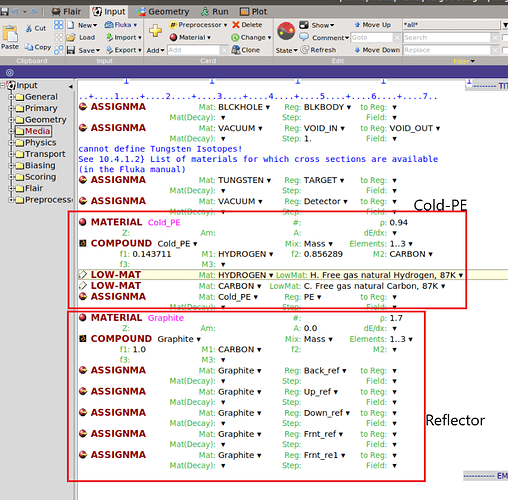Dear Fluka experts,
I am wondering if it is possible to define Polyethylene as a material at a low temperature such as 87 K.
It is appreciated if you have any suggestion.
Thanks.
Mahdi
Dear Mahdi,
Polyethylene as material is readily available in FLUKA under the name POLYETHY with a density of 0.94 g/cm^3. However, I assume that you would like to either adjust the material density or set the correct cross sections at 87K or both.
To approach this, I believe the best way forward is to define a a new compound material. Using a MATERIAL card, you can set any specific density and also define a new name (if you name it POLYETHY the standard pre-defined compound will be overwritten).
At these temperatures it is important to properly set the low energy neutron cross sections if applicable to your study, these will need to be defined on single-material level. This means that you can define two new materials with a MATERIAL card each, H at 87K and C at 87K to make the new COMPOUND polyethylene at 87K material. For both H and C at 87 K you can reset the low energy neutron cross sections to this temperature. For this you can check the list of available materials for which the cross sections are defined at 87K. Using the identifiers in this list you can associate the correct data set using a LOW-MAT card to both H and C.
Let me know if this answers your question, cheers!
Andreas
Dear Andreas,
Thank you for your clear answer. Yes, I would like to set the correct cross-sections at 87 K.
However, I am wondering if I define H and C at 87 separately, the result will be similar to the case
when H is bounded in CH2.
I appreciate your response.
Mahdi
Hi Mahdi, in the library there is indeed no H bounded cross sections at 87K, in this sense you are restricted to what is available in FLUKA. I would suggest to try to both and compare the results between using H free cross section at 87K and using the H bound cross section at 296K. This should give an idea on how the final result of your study depends on this change.
Cheers,
Andreas
Dear Andreas,
Yes, you are right and I should check it at 296K.
By the way, in my input file I have Carbon in Polyethylen and also I have Carbon as the graphite which is a reflector. So I tried to use the LOWMAT card for H and carbon at 87K.
How can I make sure that the LOWMAT card is applied to the Cold-PE and not the reflector? I have attached a screenshot of the material card.
I appreciate your comments.
Thanks.
Mahdi
Hi Mahdi,
The LOW-MAT cards have to be explicitly connected to a particular isotope. Hence the safe/best thing to do is explicitly define two Carbon materials with each a LOW-MAT card associated to it (so you will need another one). These two materials you can then include in the different compound materials.
Cheers,
Andreas
